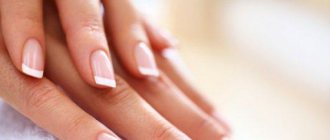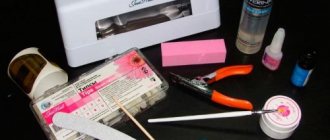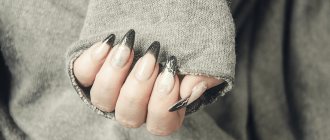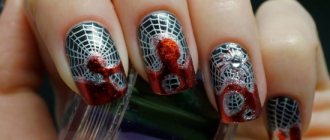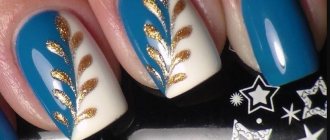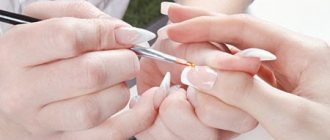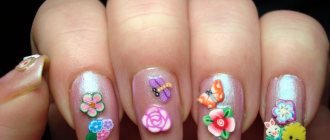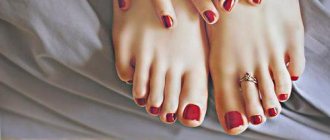Types of correction of extended nails
All types of correction are classified according to the complexity of the work :
- Small. Least labor intensive. Includes minor editing of the drawing or painting over cracks. It is also required if the nail has been slightly damaged mechanically (its edge has been trimmed or the varnish has worn off a little);
- Average. This is the re-extension of an artificial plate on top of a natural one. It looks natural after any manicure. Includes painting and finishing a “fresh” edge;
- When a nail breaks, a complex correction is made. If the model breaks the plate or wears off the polish, the master repeats the manicure procedure on one or more fingers. The same type of work is used to deform the coating.
If the correction of overgrown nails is a natural process, then the correction of broken or cracked plates is a necessary measure. To avoid this, simply handle them carefully, try to minimize exposure to household chemicals and do not test them for strength.
What is correction and when is it necessary?
Correction of eyelash extensions is a procedure for partially replacing artificial hairs, as well as filling the resulting voids in the eyelash row. After all, natural eyelashes tend to renew themselves at certain intervals. And the consequence of this process is their natural loss at the end of the life cycle.
Each hair goes through 4 main stages of development:
- anagen - active growth occurs;
- catagen - the hair is at rest;
- telogen - aging phase;
- early anagen - a mature eyelash makes room for a new one.
The more nascent eyelashes there were at the time of extension, the sooner correction will need to be made. Usually the specialist himself determines in advance when this procedure will need to be carried out. But in each individual case, correction may be needed either earlier or later than the appointed time. If you notice that your eyelashes have grown significantly, have started to look in different directions, or are partially peeled off, it’s time to write to your favorite specialist and go for a correction procedure.
Step-by-step instructions for correcting nails with gel
Correction of gel nails at home includes:
- Removing old material;
- Shaping;
- Removing overgrown cuticle;
- Manicure with gel polish.
Let's look at each stage in more detail. To remove old gel polish
It is most convenient to work with a router. Of course, you can use special solvents or file away the biogel, but this is an atavism.
A milling cutter is a special machine that is used during manicure, nail extension and correction. Includes attachments for filing, polishing, and smoothing uneven plates. The cutters allow minimal trauma to the plate and remove old varnish much faster.
Fraser
After this, using a nail file or the same manicure cutters, the nails are given the desired shape
. It is important not to leave too thin edges, otherwise they will easily break even with everyday use. For beginners, it is best to limit yourself to the classic semicircle.
Now the nails are soaked in a bath to soften the cuticle
. The skin itself is moved from the plate into a hollow, where it is cut out with nippers or scissors. You can also buy a cuticle softener, which will allow you to remove it without cutting tools.
Step-by-step instructions for correcting nails with shellac at home (plus photos):
- A degreaser is applied to the plate. It needs to be carefully distributed, you can go a little onto the skin;
Degreasing the plate - When the degreaser is completely absorbed, it is necessary to apply a coating layer of gel or base. To do this correctly, work with a flat, wide brush. This way there will be no stains, and the shellac will be able to spread evenly;
Applying base gel polish - After this, a camouflage layer is applied. You can apply any drawings to it or make a jacket;
Applying camouflage shellac - The next stage is the application of a transparent modeling layer. For the first time, it will be quite difficult for yourself to apply it evenly and accurately. Therefore, it is important to practice beforehand;
- The surface (after drying, of course) is sanded first with a file, then with a soft buff;
Immediately after drying the gel correction - Only after this polishing is the nail coated with finishing gel polish and the correction is completed. Reviews say that after the session you can wait another month before the next procedure. This saves a lot of time and money.
It is important to note that the technique for working with single-phase gel is almost identical, with the exception of speed. This type of nail design and correction can be done many times faster than with regular shellac. That's why it's called express technology.
What is better to choose - correction or new extensions?
It can be difficult to answer this question on your own. This requires the experienced eye of a master. The decision depends on the individual characteristics of each client’s body. After all, all processes in our body occur at different speeds, including the growth and renewal of eyelashes. The master's verdict will depend on what percentage of eyelash extensions will remain at the time of the procedure. If a specialist offers two options, then it’s up to you to make a choice. Correction will cost less than re-extension. And it will take less time. However, you should not abuse it.
Correction of acrylic nails
Before correcting extended nails with acrylic, it is important to prepare all the tools :
- File with coarse grain (wide, optimally 100x100);
- Cap for monomer (a product is collected into it to avoid overconsumption);
- Powder;
- Degreaser, primer;
- Acrylic;
- Brushes and pipette.
You can use regular alcohol or any alcohol-based tonic as a degreaser - they have the same functions. Also, before correction, the old varnish is removed and the nail is slightly filed.
Nail correction and extension set for beginners
Step-by-step instructions for beginners with a video on how to correct nails with acrylic:
Video: Correction of gel nails (nail design lessons)
- The cuticle is moved to the very bottom of the nail, after which the filing is made. The technology is the same as for extensions. From the cuticle down to the hole, the file moves in a circular motion. This is necessary because the plate grows unevenly. The goal is to equalize the old acrylic to the level of the natural surface;
Removing old acrylic material - Next, a quick cleaning is carried out to remove the characteristic deposits after sawdust. A napkin, brush or towel is suitable for this;
- As when working with biogel, first the surface of the nail is degreased. Afterwards, a primer is applied to the dried plate;
- Now take a capsule for the monomer and the acrylic itself. Using a pipette, the required amount of product is collected. Next, a brush is dipped into the capsule; first it needs to be well moistened with acrylic. Afterwards, everything unnecessary is brushed onto the walls of the container with monomer;
Set of powder for brush with acrylic - A small amount of acrylic is collected on the tip of the brush, then it is lowered with the same tip into the powder and a ball is collected on it in a circular motion;
- The resulting ball must be distributed very quickly and evenly over the plate;
Stretching an aryl ball - When distributing the powder, special attention is paid to the place where there is a seam between the old acrylic and the natural plate. The brush is slightly pressed into this area;
- Before each next layer, be sure to wipe the brush on a napkin so that there is nothing unnecessary on it;
- Correction with acrylic is most often carried out on tips. To do this, you need to attach the form to the plate and select the desired length according to it. It needs to be placed under the nail and completely adjusted to the shape - so that there are no gaps or sharp transitions;
Forming an acrylic plate - The acrylic in the capsule is replaced and correction work is resumed. The system is the same as before. The brush is soaked in monomer and then dipped in powder. The product is applied over the staples;
Fixation tips - All that remains is to dry your nails and paint them. You can make bright long claws with plates or, conversely, a flirty French correction of extended nails.
Many modern ideas for correcting acrylic nails include the use of gel polish. Outwardly it looks very natural (if the correct length and shape are chosen).
How often can the correction be repeated?
How many times can the correction be carried out? You can do this procedure an infinite number of times. But this is only in theory. In practice, this is not recommended. The reason lies in hygiene. The fact is that while artificial hairs are glued to your eyelashes, it is quite difficult to provide them with proper care. To maintain cleanliness in this area, it is necessary to more carefully carry out the procedure for daily cleansing of the interlash space. Even using a special brush does not help completely free the hairs from accumulated impurities. Sebum, particles of dust and decorative cosmetics can lead to irritation and inflammation over time.
Therefore, it is recommended to carry out correction no more than twice from the moment of extension. And although the correction procedure is cheaper, health should remain first!
Laser correction of ingrown toenails
A separate topic for many girls is the correction of ingrown nails with a laser device. This technique appeared relatively recently, but quickly became the most effective in solving this problem.
Laser nail correction
An ingrown toenail is an unpleasant and dangerous phenomenon. For example, if it grows into the leg, it can cause gait distortion or injury. For some time, a pedicure on the foot can save you from it, but often the effect lasts for less than 2 weeks.
How to perform laser correction of a toenail step by step:
- The technology includes exclusively medical intervention. You shouldn’t expect them to give you a pedicure or file a plate – this is what beauty salons do. First, you will need to fill out some paperwork and choose a suitable painkiller, then, together with your doctor, decide on the type and strength of the laser beam;
- Pain relief can be carried out with lidocaine subcutaneously or using special creams (ointments);
- The skin ridge is removed first. It is this that is the main cause of improper growth of the plate. The doctor simply burns it out with a carbon laser;
- Under the ridge there is almost always a process, which is the main cause of ingrowth. It is adjusted using tweezers and supported with gauze turunda for fixation;
- The treated area will require special care for several days. If it’s summer outside, it’s important to avoid dust and dirt, and also avoid swimming in open water; if it’s winter or autumn, it’s recommended to wear loose shoes.
The average price of laser correction is $10 per session. To find out exactly how much a procedure costs, you need to consult with a doctor personally, demonstrate the scope of work and choose the optimal treatment option.
How the correction is done
Correction usually takes less time than extension procedures. This is explained by the fact that the specialist no longer needs to shape the entire eyelash row, but rather determine which hairs need to be replaced. Most often, these hairs are no more than half of those extended the previous time. And in addition to replacing some hairs, it is sometimes necessary to fill the resulting voids in the eyelash row.
There is nothing complicated in the correction procedure, but it is necessary to go through several mandatory stages to ensure the maximum duration of the result.
- Before correction, it is necessary to diagnose the appearance of the eyelashes. To do this, the master visually assesses the condition of the hairs, asks how comfortable it was for you to wear eyelash extensions and whether any problems arose.
- The next step is to comb the entire eyelash row. At the same time, all the hair extensions that were barely holding on will come off. The technician will also be able to determine which of them are on the verge and therefore need to be replaced.
- Once it has become clear which artificial hairs are not holding well enough to last at least a couple more weeks, the specialist will begin to remove them. To remove them pointwise and carefully, so as not to get on the delicate mucous membrane of the eyes, a remover is used, and special tweezers are also used.
- Before gluing new hairs, the master carries out a very important process of degreasing the eyelashes and interlash space using special products. The eyelashes must be cleared of anything that could interfere with the adhesion of the artificial hair to the natural one.
- And the last stage consists of directly re-extending hairs in places that required correction. The length and bend are selected taking into account the artificial hairs remaining from the previous extension.
It is best to come for the correction procedure to the specialist who did the extensions for you.
This is explained by the fact that specialists in their work give preference to eyelashes from different brands. This means that the quality, length, thickness and curvature of the materials used may vary. If for some reason you decide to change your hairdresser, then it is better to sign up for re-extensions rather than corrections. Then you will avoid disharmony as a result.
Signs of poor quality correction
If all the conditions necessary for correction are met, no peeling or removal of the material will be observed. On the contrary, peeling indicates either that this material should not be used, or a violation of the technological process. A detachment of 1-1.5 millimeters is considered normal. Possible reasons for this problem may be:
- Careless handling of nails
- Free edge length too long
- Consequences of antibiotic treatment
- Aggravated chronic diseases
- Exposure to household chemicals
- Failure to comply with technological rules during expansion or correction.
Bright ideas for French extensions
In the presented master class, we looked at the classic design of a French manicure - a soft pink base of the nail and a white free edge. Not all girls are fans of the classics, and many want brighter and juicier options. In the case of French extensions, this is not a problem: you can choose a gel coating of any color that you want to color your smile line. In the photo below you can see the French design in different color variations.
Of course, you can decorate your nail art in many different ways. Your design of French extensions will be perfectly complemented by all kinds of drawings, stickers, rhinestones or glitter. The good thing about extensions is that you choose the length of your nails yourself, which means you can plan in advance the future composition that you want to implement in your nail art. We present to your attention a collection of photos with elegant and stylish options for extended French manicure.
In conclusion, we have prepared another useful video lesson for you, in which Victoria will demonstrate to you the second method of French nail extensions - using laying out. The technology is somewhat different from the option proposed in the master class above, but many masters prefer this method. Evaluate which method is clearer and more convenient for you. The choice is yours. Don’t be afraid to experiment and explore new horizons - you will succeed!
What materials will be needed for correction?
Before you start, don’t be lazy to visit a specialized store and buy:
- Acrylic remover
- Coupling agent (primer)
- Acrylic
- Degreaser
- Set of files for polishing nails
- A brush.
These materials can be purchased either as a set or individually.
What troubles might arise?
Even if the correction procedure went as it seemed to you in compliance with all the required conditions, minor troubles cannot be ruled out. Let's look at the reasons for their manifestation:
- If your nails break: They may be filed too thin or too long.
- Nail separation in the cuticle area: the shape or length of the nails is incorrectly chosen, the previous acrylic coating is poorly removed, the nail plate is not cleaned enough.
- The appearance of cracks on the free edge of the nail: the edges are poorly covered with acrylic or the acrylic is very thinly filed along the edges; the cracks were not removed during correction.
These reasons are not the only ones. Much depends not only on skill, but also on the tools and products that will be used to correct nails.
